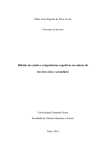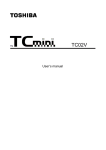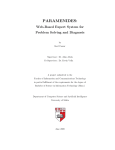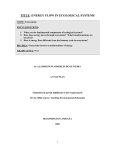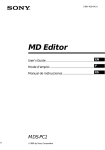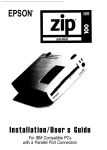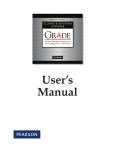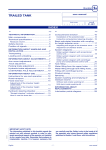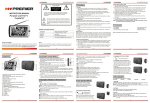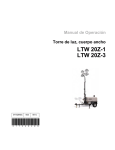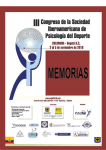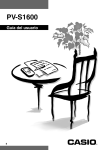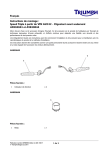Download Estimator 7.0 User`s Manual - Academic Success for All Learners
Transcript
ESTIMATOR Version 7.0 USER’S MANUAL For Use With IBM PC and PC-Compatible Computers Richard D. Baer, Ph.D. and Brad Althouse, M.S. EIMS Corporation 1430 Canyon Road #2 Logan, Utah 84321 Business Office: (435) 752-6305 in cooperation with the Center for Persons with Disabilities Utah State University Logan, Utah © copyright 1999, EIMS Corporation ESTIMATOR is a product of the EIMS Corporation. Therefore, INTERNATIONAL BUSINESS MACHINES, INC. and MICROSOFT, INC. MAKE NO WARRANTIES, EITHER EXPRESSED OR IMPLIED, REGARDING THE ENCLOSED COMPUTER SOFTWARE PACKAGE, ITS MERCHANTABILITY OR ITS FITNESS FOR ANY PARTICULAR PURPOSE. Other product names used in this publication are for identification purposes only, and may be trademarks of their respective companies. Table of Contents Page 1 2 3 I. Introduction Purpose Equipment II. Installation Instructions for ESTIMATOR Windows 95/98/NT Installation Windows 3.1x Installation 3 3 4 III. The ESTIMATOR Program 7 IV. Running the Program Information You Will Need Currency of Data Entered In What Order Should the Data be Entered Staying with ESTIMATOR 12 12 13 13 13 V. Output and Interpretation Informational Messages Grade-Based Estimated Data Averaged Data Default Data Discrepancy Cutoff Check Intellectual Versus Learning Disabilities 14 14 14 15 15 16 16 17 VI. Reports Summary of Discrepancy Information Explanation of Percent Likelihood Technical Intermediate Data 18 18 19 20 Appendices A. B. C. D. Calculating the Utah Discrepancy Formula Tests Approved for Use in Utah Student’s Most Serious Problem Area Request to the USOE to Add a Test 21 31 59 63 Acknowledgments Development of the Estimator program was supported by Utah State Office of Education, Services for Students at Risk. Special thanks are extended to Mae Taylor, Director, and Dale Sheld, Specialist - Learning Disabilities/Communication Disorders for their cooperation and encouragement. The contribution of Utah’s LD Test Selection Committee is gratefully recognized. Members include: Richard Keene, Past Chairman, Utah State Office of Education Vickey Carleson, Speech Pathologist, Iron School District Mary Griffin, Psychologist, Logan School District Phil Fast, Psychologist, Davis School District Gail Brown, Psychologist, Utah Department of Health Tony Loveless, Psychologist, Iron School District Hal Sanderson, Utah State Office of Education Members of this group, painstakingly, reviewed the formula and all tests included in the program. They also made many helpful suggestions for improving the look and user friendliness of ESTIMATOR. Particular thanks are extended to Richard Keene, Past Chairman of the Committee, whose leadership and strong command of tests and measurements ably guided development of the program. Dr. Keene developed the formula modifications (see Appendix A) that are at the heart of Estimator: Version 7.0. Finally, the contributions of Alan Hofmeister and Joe Ferrara whose early work in artificial intelligence led to development of the original ESTIMATOR program in the 1980s, is gratefully acknowledged. Introduction In 1988, the Utah State Office of Education (USOE) adopted a formula for evaluating the discrepancy between a student’s expected and obtained educational achievement. Until now, Utah’s formula has been the one recommended in the report of the United States Department of Education, Special Education Programs Work Group on Measurement Issues in Assessment of Learning Disabilities (Reynolds, 1984-85 * ). With the publication of Estimator: Version 7.0, the original formula has been modified. the new formula retains the basic regression characteristics of its predecessor, but incorporates a one-tailed test (the original formula employed a two-tailed test) and a mathematically more elegant way of correcting for test unreliability (see Appendix A). In addition to modifying the formula, changes have been made in the way the program output is reported. Version 6.0 The previous version, 6.0, determined the achievement score where one could be 95 percent confident that a student exhibited a severe discrepancy (cutoff score). It then considered the obtained achievement score and generated a percent likelihood that the obtained score was equal to or greater than the cutoff score. If the obtained score was equal to the cutoff score, there was a 50 percent likelihood that the student exhibited a severe discrepancy. Students whose obtained scores represented a 50 percent likelihood of a severe discrepancy or greater were considered to have met severe discrepancy criterion for LD eligibility; those whose obtained scores represented less than a 50 percent likelihood were considered not to have met criterion. Version 7.0 Version 7.0: • Does not generate a percent likelihood. • Generates the percent confidence one can have that a student exhibits _________________________ * Reynolds, C.R., (1984-85). Critical measurement issues in learning disabilities. The Journal of Special Education 18(4), 451-476. 1 a severe discrepancy. • Uses a 93 percent cutoff. If the confidence one can have that a student exhibits a severe discrepancy is equal to or greater than 93 percent, the student meets severe discrepancy criterion for LD eligibility; if the confidence is less than 93 percent, the student does not meet severe discrepancy criterion for LD eligibility. Initial research on the new formula showed that the 93 percent cutoff used by the new formula is similar to the 50 percent likelihood used by the old formula. Users of Estimator: Version 6.0 should not notice a substantial difference in the number and type of students identified as exhibiting a severe discrepancy by Estimator: Version 7.0. • Reports (1) the cutoff score at which one can be 93 percent confident the student meets severe discrepancy criteria, and (2) the standard error of measurement of the achievement test. These statistics can be used to estimate the likelihood that an obtained score is equal to or greater than the cutoff score. Purpose ESTIMATOR is a computer program designed to use the Utah formula to determine the probability that a student’s discrepancy is severe enough for LD classification. A step-by-step procedure for calculating discrepancy with the formula is found in Appendix A. Using the formula requires knowing the reliability of the aptitude (IQ) and achievement tests administered to a student as well as the test to test correlation. Also, somewhat lengthy calculations are required. ESTIMATOR was developed to make using the discrepancy formula easy. The program contains reliabilities and test to test correlations for all aptitude (IQ) and achievement tests approved for making LD classifications in Utah. It also makes rapid and accurate calculations, saving time and eliminating the possibility of error. Finally, it generates a report summarizing discrepancy data for individual students and appropriate for documenting discrepancy data considered in LD classification decisions. ESTIMATOR deals only with discrepancy calculation, one element in the LD qualification process. Additional information such as observational data, criterion referenced test data, intervention history and social history must be considered before a student is classified as LD. 2 Equipment The ESTIMATOR program is designed to be run on two families of computers: 1) IBM PC and PC compatible computers using Windows or Windows 95/ 98/NT and 2) Apple Macintosh computers. Disks for each family of computers are color coded. Disks for IBM PCs and compatibles have labels printed in blue ink. Disks for Macintosh computers have labels printed in green ink. The disks are NOT interchangeable! For example, PC disks will not work on Macintosh computers. This manual contains instructions for the IBM PCs and compatible series. Disks for IBM PCs and compatible computers were packed with this manual. The disks packaged with this manual contains ESTIMATOR: Version 7.0. All previous versions (1.0 - 6.0) of the program are obsolete and should be destroyed. Installation Instructions for ESTIMATOR Installing the Program This program must be used on PC compatible computers running Microsoft Windows. There are three installation disks which can be used to install Estimator on systems using Windows 3.1x (Windows 3.1or Windows 3.11,Windows for Workgroups) or Windows 95/98/NT. Follow the directions appropriate for your operating system. Windows 95/98/NT Installation: 1. Insert the Installation Disk 1 into the floppy drive 2. Run the installation Program: A. Select “Run” under the Start Menu B. In the Run box, Select “Browse” C. In the Browse box, go to the “Look in” window displaying the computer’s drives and select the floppy drive into which you put the installation disk. It will probably be “A” or “B”. D. Double-Click on “Setup.exe” in the “Browse” box 3 E. Click on the “OK” in the Run box (A setup window appears containing “copying installation files” and files are copied) (A second setup window appears containing “Please insert the disk labeled; ‘Disk 2’ into drive designated.”) F. Remove Installation Disk 1 and insert Disk 2. G. Click on the “OK” button to continue (The setup window re-appears containing “copying installation files” and files are copied) 3. Respond to the Installation Program: A. A welcoming screen appears. You are warned to exit all programs before installing Estimator. When you have closed any open programs, click on “OK” to continue. B. On the next screen, you may select the drive and folder where the ESTIMATOR program files will be installed. Click on “Change directory” to change the directory where ESTIMATOR will be installed. To continue with the installation, click on the button containing the picture of the computer. (files are copied) (A setup window appears containing “Please insert the disk labeled; ‘Disk 3’ into drive designated.”) C. Remove Installation Disk 2 and insert Disk 3. D. Click on the “OK” button to continue (files are copied) (A program group and icons are created) E. A setup window appears containing “Estimator Setup was completed successfully.” Click on the “OK” button to end the Setup program. 4. To Run the program: A. Click the Start button, then move the pointer arrow to Programs, then to the ESTIMATOR 7.0 group, then to the ESTIMATOR 7.0 program, then click. B. The program will show an introductory screen. Click “OK” to continue. 4 Windows 3.1x Installation: 1. Insert the Installation Disk into the floppy drive 2. Start windows (if it is not already running) 3. Run the installation Program: A. Select “Run” under the File Menu B. In the Run box, Select “Browse” C. In the Browse box, go to the “Drives” window and select the floppy drive into which you put the installation disk. It will probably be “A” or “B”. D. Double-Click on “Setup.exe” in the “Browse” box E. Click on the “OK” in the Run box (A setup window appears containing “copying installation files” and files are copied) (A second setup window appears containing “Please insert the disk labeled; ‘Disk 2’ into drive designated.”) F. Remove Installation Disk 1 and insert Disk 2. G. Click on the “OK” button to continue (The setup window re-appears containing “copying installation files” and files are copied) 3. Respond to the Installation Program: A. A welcoming screen appears. You are warned to exit all programs before installing Estimator. You may move between running programs by using the ALT-TAB key combination. When you have closed any open programs, click on “OK” to continue. B. On the next screen, you may select the drive and folder where the ESTIMATOR program files will be installed. Click on “Change directory” to change the directory where Estimator will be installed. To continue with the installation, click on the button containing the picture of the computer. (files are copied) (A setup window appears containing “Please insert the disk labeled; ‘Disk 3’ into drive designated.”) 5 C. Remove Installation Disk 2 and insert Disk 3. D. Click on the “OK” button to continue (The setup window re-appears containing “copying installation files” and files are copied) (A program group and icons are created) E. A Setup window appears containing “Estimator Setup was completed successfully.” Click on the “Finish” button to end the Setup program. 5. To Run the program: A. Find the ESTIMATOR 7.0 program manager group, Double-Click on it if it is not opened. B. Find the ESTIMATOR 7.0 program icon in the ESTIMATOR 7.0 folder. Double-Click on it. C. The program will show an introductory screen. Click “OK” to continue. 6 The ESTIMATOR Program The parts of the main screen for the ESTIMATOR program are shown labeled below. The Consultation Information area has fields for entering the date of the consultation and the name of the person entering the data. The Student Information area has fields for entering the student’s name, school, grade, and date of birth. The Aptitude (IQ) Test section contains a summary of the data entered in the Aptitude Test screen. The Achievement Test section contains a summary of the data entered in the Achievement Test screen. The File menu contains the Exit option, and the Help menu contains Introduction and About information. Click here to start completely clean. Click this button to go to the Report screens. Click here to end your consultation with ESTIMATOR (works the same as Exit in the File menu). 7 The Aptitude (IQ) Test screen appears when the Enter Aptitude (IQ) Test Data button is clicked on the main screen. The parts of the Aptitude (IQ) Test screen are shown labeled below. The Examination Information section has fields for entering the name of the examiner and the date of testing. A message shows the age at testing based on the date of birth (from the main screen) and the date of testing. The Aptitude Test Information section has “combo boxes” (lists that appear when you click on the arrow on the right side) for the aptitude tests and subscales of the selected test. This section also contains a field for entering the student’s score on the test (a message displays the mean and standard deviation for the score). Click this button when you have completed the information on this screen. Click this button if you got to this screen by mistake, or if you don’t want to save changes you have made on this screen. 8 The Achievement Test screen appears when the Enter Achievement Test Data button is clicked on the main screen. The parts of the Achievement Test screen are shown labeled below. The Examination Information section has fields for entering the name of the examiner and the date of testing. A message will show the age at testing based on the date of birth (from the main screen) and the date of testing. The Achievement Test Information section has “combo boxes” (lists that appear when you click on the arrow on the right side) for the achievement area (basic reading, listening comprehension, etc.), achievement tests for the selected area, and subscales of the selected test. This section also contains a field for entering the student’s score on the test (a message displays the mean and standard deviation for the score). Click this button when you have completed the information on this screen. Click this button if you got to this screen by mistake, or if you don’t want to save changes you have made on this screen. 9 The ESTIMATOR Report screen appears when all required information has been entered and the Create Report from this Information button is clicked. The parts of the Report screen are labeled below. The scrolling text window contains the text of the report generated for this student. Use the scroll bar on the right side to move through the report. Click here when finished to return to the main screen. Click here to save the report as a file. Click here to print a copy of the report. Click here to go to a screen containing an explanation of the “percent confidence” used by ESTIMATOR. Click here to go to a screen containing some of the intermediate values calculated by the ESTIMATOR program. 10 The Percent Confidence Explanation screen and the Technical Data screen are the same, except for the content of the scrolling window. The parts of the Technical Data screen are labeled below. The scrolling text window contains the text of the report generated for this student. Use the scroll bar on the right side to move through the report. Click here to save as a file. Click here when finished to return to the Report screen. Click here to print a copy of the report or explanation displayed in the scrolling window. 11 Running The Program Information You Will Need The ESTIMATOR program asks for the following information when you run a consultation: Consultation Information: Date of the Consultation Name of Person Entering the Data Student Information: Name Date of Birth School Grade Aptitude (IQ) Test Information: Name of Examiner Date of Testing Aptitude (IQ) Test Name Name of the Aptitude Test Sub Scale (from the test protocol) Student’s Aptitude Test Score Achievement Test Information: Name of Examiner Date of Testing Name of the Student’s MOST SERIOUS academic problem area Achievement Test Name Name of Achievement Test Sub Scale (from the test protocol) Student’s Achievement Test Score The test and score names which may be used for discrepancy determination in Utah are listed in Appendix B. 12 Currency of Data Entered ESTIMATOR 7.0 is a tool designed to assist school teams in determining if a severe discrepancy is present at the time a student is considered (reconsidered) for LD eligibility. In light of this, it is recommended that test data entered into the program be reasonably current at the time the decision is made. Users entering non-current data should be prepared to defend the position that the data entered represent intellectual ability and academic achievement at the time of the decision. In What Order Should the Data be Entered? The ESTIMATOR program is not too particular about the order that information is entered into the fields. The most important thing to remember is: DATES DRIVE THE PROGRAM! Explanation: A particular test has only been approved for use with students for a specific range of ages. The approved age range for each test has been determined by the Utah State Office of Education. In order to assist educators in making sure that an approved test was used for the student, the ESTIMATOR program determines the age of the student at the time of testing and presents a list of tests consisting only of those tests approved for that age. This means that ESTIMATOR must have a valid date of birth and a valid date of testing before any test name or subscale can be selected. This also means that if the birthdate or date of testing are changed, some information might become invalid and will be thrown out by ESTIMATOR. NOTE: If you want to move quickly through the data entry process, start with the Date of Consultation field and press Enter or Tab after entering the data. The program will automatically move you to the next field. Staying with ESTIMATOR You may find that you are suddenly out of the ESTIMATOR program. What has probably happened, is that you have inadvertently clicked off of the ESTIMATOR screen and changed the active program to another you had running. In Windows 95/98/NT you can restore ESTIMATOR by clicking on ESTIMATOR’s button on the taskbar. In Windows 3.1, hold down ALT and press TAB to move through the list of active programs - release ALT when you see ESTIMATOR 13 Output and Interpretation Informational Messages Anyone wishing to calculate discrepancy using the Utah formula for LD determination must have access to three critical values. They should know the reliability of each test score and the correlation between those scores (see Appendix A). In many cases, these data have been made available by test publishers. When these data are available, ESTIMATOR uses them. Often, for a variety of reasons, these data are not available. When they are not, ESTIMATOR uses default values. Grade-Based Data In some cases, test data (reliability and correlation) are provided by test manufacturers by grade, rather than by age. ESTIMATOR is set up to use agebased data. When only grade data is available, ESTIMATOR assumes that the following age/grade relationship is true. Grade K 1 2 : : 12 Age 5 yrs 6 yrs. 7 yrs. : : 17 yrs. ESTIMATOR sends the message shown below to let the user know exact data is not available: “Age specific data is not currently available on the internal reliability of the [Test Name]/correlation between [Test One] and [Test Two]for the specified age. The grade-level based value of [Value] is being used for the reliability/ correlation of this/these test/tests.” 14 Estimated Data In certain cases, exact data on a test may not be known; however, an estimate can be made. For example, if a test’s reliability at age 8 is know to be .95 and its reliability at age 10 is known to be .95, it is reasonable to assume that its reliability for age 9 is about .95. ESTIMATOR sends the following message to let the user know when estimates, rather than published data, are being used: “Exact data is not currently available on the internal reliability of the [Test Name] for the specified age.” or Exact data is not currently available on the correlation between the [Test Name] and the [Test Name] for the specified age. The estimated value of [Value] is being used for the reliability correlation of this/these test/tests. Averaged Data There are rare cases when there is reliability or correlation data for periods of less than 1 year. In those cases, since ESTIMATOR currently stores that data for 1 year intervals, ESTIMATOR uses the average of the values. ESTIMATOR lets the user know when an averaged value is being used by sending the following message: Exact data is not currently available on the internal reliability of the [Test Name] for the specified age. or Exact data is not currently available on the correlation between the [Test Name] and the [Test Name] for the specified age. The averaged value of [Value] is being used for the reliability / correlation of this/these test/tests. 15 Default Data There are cases when we have no idea what the correlation between two tests is. In those cases, ESTIMATOR uses a default value of .50. ESTIMATOR lets the user know when a default value is being used by sending the following message: Data is not currently available on the correlation between the [Test Name] and the [Test Name] for the specified age. The default value of [Value] is being used for the correlation of these tests. Discrepancy Cutoff Check For any pair of tests entered, ESTIMATOR checks to determine if it is possible for the student to score low enough on the achievement test to reach the cutoff score needed to be 93 percent confident there is a discrepancy between actual and predicted achievement. To illustrate, consider a student age, 6 years, 0 months who is administered the Wechsler Intelligence Scale for Children - Third Edition (WISC-III) and the Reading Comprehension Tests of the Woodcock-Johnson Psycho-educational Battery: Part II - Revised (WJ-R). With a WISC-III Full Scale IQ score of 90, ESTIMATOR determines that to reach the 93 percent cutoff on the WJ-R Reading Comprehension scale the student would need a score of 76. It next checks to determine the lowest possible score a student 6 years, 0 months can attain on the WJ-R Reading Comprehension scale. This score is determined to be 81; a student 6 years, 0 months with a raw score of 0 on the WJ-R Reading Comprehension scale attains a Reading Comprehension Standard Score of 81. Comparing the cutoff score, 76, with the lowest attainable score, 81, ESTIMATOR determines it is not possible for the student to reach the 93 percent cutoff score. ESTIMATOR also checks to see if one can be 95 percent confident that the obtained score is above the lowest possible score. It does this by adding two standard errors of measurement (SEM) to the lowest possible score and determining if the obtained score is lower than the sum. In the example, the lowest possible score is 81 and the SEM is 2.6. Thus, 81 + 2 x 2.6 = 86, the score where one can be 95 percent confident a score is greater than the lowest possible score of 81. Since the obtained score of 85 is less than 86, ESTIMATOR concludes one cannot be 95 percent confident the obtained score is above the lowest possible score. When one is 95 percent or more confident the obtained score is above the lowest possible score, one can also be at least 95 percent confident the obtained score is above the 93 percent cutoff score. However, 16 when one cannot be 95 percent confident the obtained score is above the lowest possible score, the possibility of a floor effect arises. One cannot be sure that if another achievement test with a lower floor than the original test was given, that the student would (1) not score below the lowest possible score of the original test, and (2) not score low enough to reach the 93 percent cutoff score. When both of the conditions described above exist, ESTIMATOR sends the message: For a child of this age, the lowest scaled score on the achievement test administered is above the 93 percent cutoff score. The cutoff score would need to be reached to demonstrate a severe discrepancy. Additionally, there is less than 95 percent confidence that the obtained score is greater than the lowest possible standard score. Therefore, the achievement test is inappropriate for this child and administering another achievement test with a lower floor is indicated (see the Estimator manual for additional explanation). This check warns decision makers when inappropriately-scaled achievement tests are entered into discrepancy calculations, and helps avoid disqualifying students who might be qualified with more appropriately-scaled achievement tests. Intellectual Versus Learning Disabilities Utah Special Education Rules specify that students must score above the intellectual disabilities range, two standard deviations below the mean, on individually administered tests of intellectual ability in order to be classified as learning disabled. When an aptitude (IQ) score within the intellectual disabilities range is input, ESTIMATOR sends the following message: Utah Special Education Rules specify, “the student with learning disabilities must score above the Intellectual Disabilities range on individually administered tests of intellectual ability.” The aptitude (IQ) score entered does not meet this criterion; therefore, classification as a learning disabled student is not advised. 17 Reports Summary of Discrepancy Information The document below is available in the program and displays a summary of the information entered into the ESTIMATOR program. Summary of Discrepancy Information Consultation Date: 9/15/1999 Data Entered by: Michelle Smith Student Name: Dianne Johnson School: Lakeside Middle School Date of Birth: 8/4/1988 Grade: 6 ============================================================= Aptitude/IQ Test: Kaufman Assessment Battery for Children (K-ABC) Scale: Mental Processing Composite Standard Score Score: 108 Date of Examination: 9/8/1999 Age at Testing: 11: 1 Examiner: Richard Jackson Achievement Area: Basic Reading Skills Achievement Test: Woodcock Reading Mastery Tests - Revised Scale: Basic Skills Cluster Standard Score - Form G Score: 85 (SEM = 3.354) 93% Cutoff Score: 83 Lowest Possible Standard Score: 21 Date of Examination: 9/9/1999 Age at Testing: 11: 1 Examiner: Denise Barber ============================================================= Based on the test data entered, the school team can be 91 percent confident the difference between the student’s expected and obtained achievement scores represents a severe discrepancy. In order to qualify a student, the school team should be at least 93 percent confident there is a severe discrepancy between the student’s expected achievement score and the obtained achievement score. Therefore, this student does not meet the severe discrepancy criteria for specific learning disabilities eligibility. It is important to remember that the confidence listed above refers ONLY to DISCREPANCY. State and federal law REQUIRES multidisciplinary assessment teams to consider other data before determining eligibility for LD placement. Those additional data are listed in the current edition of Sta the Board of Education Special Education Rules. ============================================================= The discrepancy formula contained in the Estimator program assumes the user is comparing one aptitude (IQ) test score with one achievement test score and that there is prior reason to believe the student is having difficulty in the achievement area. The program does not adjust for the increased probability of finding a severe discrepancy by chance when multiple comparisons are made. Users making multiple comparisons, for parent consultation or other purposes, are cautioned to consider these issues when interpreting reports generated by the Estimator program. 18 Explanation of Percent Confidence The ESTIMATOR program provides a number representing the percent confidence that the discrepancy between the student’s aptitude (IQ) and achievement is severe enough for LD eligibility in UTAH. The document below is available in the program and gives additional explanation to its meaning. Explanation of Percent Confidence Consultation Date: 9/15/1999 Student Name: Dianne Johnson School: Lakeside Middle School ============================================================= The purpose of the Estimator program is to assist school teams in determining if there is a severe discrepancy between a student’s expected achievement score and the obtained achievement score. This and other data are used by school teams to determine eligibility for specific learning disabilities classification. Given the statistical properties of the tests administered and an IQ score of 108, an achievement score of 103 would be expected. A cutoff score of 83 represents the point at which the school team can be 93 percent confident there is a severe discrepancy. A score at or below the cutoff score indicates a severe discrepancy. The student’s achievement score of 85 is higher than the cutoff score. The school team can be 91 percent confident the student’s achievement is lower than expected. 19 Technical Intermediate Data Appendix A shows the steps in calculating discrepancy with the ESTIMATOR formula. The document below is available in the program and gives the value of several of the key steps in the calculation. Estimator Formula Intermediate Values Consultation Date: 9/15/1999 Student Name: Dianne Johnson School: Lakeside Middle School ======================================================= 1A. IQ test standard score: 108 1B. Achievement test standard score: 85 1C. IQ test standard score mean: 100 1D. IQ test standard score standard deviation: 15 1E. Achievement test standard score mean: 100 1F. Achievement test standard score standard deviation: 15 1G. Reliability estimate for the IQ test score at the student’s age: 0.94 1H. Reliability estimate for the achievement score at the student’s age: 0.95 1I. IQ to achievement test correlation at the student’s age: 0.43 1J. IQ test z score equivalent: 0.533 (SS = 108) 1K. Achievement test z score equivalent: -1.000 (SS = 85) 2. Test-to-test correlation corrected for the unreliability of the tests: 0.4550 3. Standard error of prediction corrected for unreliability of the tests: 0.8905 4. Predicted achievement score: 103 (z score = 0.229) 5. Cutting score for the 93% confidence level: 83 (z score = -1.085) 6. Confidence that the obtained achievement test score represents a severe discrepancy: 91% 7. The criterion confidence level of at least 93% has not been met, a severe discrepancy is not indicated. 20 Appendix A Calculating the Utah Discrepancy Formula Note: Rounding differences may create differences between numbers generated by ESTIMATOR and those generated by other calculations. 21 This is a blank page in original document. 22 23 Z cut = z xr xy – 1.476 1– r xx r yy r xy 2 103 83 xi yi 1K. Achievement test z score equivalent 1J. IQ test z score equivalent (z x ) Calculate y i – yx sy x i –x x sx 98 – 100 = –.133 15 82 – 100 = –1.200 15 83 – 100 = –1.133 15 100 15 100 15 .92 .89 .58 98 82 Example 2 103 – 100 = .200 15 100 15 100 15 .90 .81 .52 Example 1 Symbol xx 1C. IQ test standard score mean . . . . . . . . . . . . . . . . . . . . . . . . . . . . . . . . . . . . . . . . . sx 1D. IQ test standard score standard deviation . . . . . . . . . . . . . . . . . . . . . . . . . . . . . . . . xy 1E. Achievement test standard score mean . . . . . . . . . . . . . . . . . . . . . . . . . . . . . . . . . . s 1F. Achievement test standard score standard deviation . . . . . . . . . . . . . . . . . . . . . . . . . y 1G. Reliability estimate for the IQ test score at the student’s age . . . . . . . . . . . . . . . . . . . r xx 1H. Reliability estimate for the achievement test score at the student’s age . . . . . . . . . . . . r yy 1I. IQ to achievement test correlation at the student’s age . . . . . . . . . . . . . . . . . . . . . . . r xy Look Up Have on Hand 1A. IQ test standard score . . . . . . . . . . . . . . . . . . . . . . . . . . . . . . . . . . . . . . . . . . . . . 1B. Achievement test standard score . . . . . . . . . . . . . . . . . . . . . . . . . . . . . . . . . . . . . . Step 1 - Getting the Data You Need Formula 24 2D. Divide the correlation between tests by the correction factor. (1I / 2C) • 2C. Multiply 2A by 2B. (2A 2B) 2B. Find the square root of the reliability of the achievement test. 1H 2A. Find the square root of the reliability of the IQ test. 1G Step 2. Calculate the correlation between tests, corrected for the unreliability of the tests. Z cut = z xr xy – 1.476 Z cut = z xr xy – 1.476 Z cut = z xr xy – 1.476 Z cut = z xr xy – 1.476 Z cut = z xr xy – 1.476 1– 1– 1– 1– 1– r xx r yy r xy r xx r yy r xy r xx r yy r xy r xx r yy r xy r xx r yy r xy 2 2 2 2 2 0.609 0.854 0.900 0.949 0.641 0.905 0.943 0.959 Example 1 Example 2 25 4A. Calculate the predicted achievement zscore. Multiply the IQ z-score by the correlation between the tests. (1J • 1I) Z cut = z xr xy – 1.476 Z cut = z xr xy – 1.476 3C. Find the square root of 3B to obtain the standard error of prediction z-score, corrected for unreliability of the tests. 3B Step 4. Calculate the predicted achievement score. Z cut = z xr xy – 1.476 Z cut = z xr xy – 1.476 Z cut = z xr xy – 1.476 3B. Subtract 3A from 1 to obtain the error variance attributable to the correlation between tests, corrected for unreliability of the tests. (1-3A) 3A. Square the corrected correlation between the tests to obtain the proportion of variance accounted for by the correlation between tests, corrected for unreliability of the tests. (2D • 2D) Step 3. Calculate the standard error of predic tion, corrected for unreliability of the tests. 1– 1– 1– 1– 1– r xx r yy r xy r xx r yy r xy r xx r yy r xy r xx r yy r xy r xx r yy r xy 2 2 2 2 2 0.104 0.793 0.629 0.371 -0.077 0.768 0.589 0.411 Example Example 2 1 26 Z cut = z xr xy – 1.476 Z cut = z xr xy – 1.476 5A. Multiply the corrected standard error of prediction by the constant for the 93% confidence level, 1.476. (3C • 1.476) 5B. Subtract 5A from the predicted achievement z-score to obtain the cutting zscore. (4A - 5A) Z cut = z xr xy – 1.476 z xr xy s y z xr xy s y z xr xy s y Step 5. Find the cutting score for the 93% confidence level. 4C. Add the mean of the achievement score to the deviation predicted achievement score toobtain the predicted achievement score. (4B + 1E) 4B. Multiply the predicted achievement zscore by the standard deviation of the achievement score to obtain the deviation predicted achievement score. (4A • 1F) Convert the predicted achievement z-score to standard score units. xy xy xy 1– 1– 1– + + + r xx r yy r xy r xx r yy r xy r xx r yy r xy 2 2 2 -1.067 1.171 102.000 2.000 -1.210 1.133 99.000 -1.000 Example 1 Example 2 27 6A. Subtract the achievement z-score from the predicted achievement z-score to obtain the achievement discrepancy in z-score units. (4A - 1K) Step 6. Find the confidence level. 1– z xr xy – 1– z xr xy – r xy yi – x y sy + xy + xy + xy r xx r yy r xy yi – x y sy r xx r yy zcut sy 5D. Add the mean achievement score to the deviation cutting score to obtain the unrounded cutting score. (1E + 5C) 5E. Round the unrounded cutting score down to the nearest integer to obtain the cutting score. zcut sy zcut sy 5C. Multiply the cutting z-score by the standard deviation of the achievement score toobtain the deviation cutting score. (5B • 1F) Convert the cutting z-score to standard score units. 2 2 1.237 83 83.995 -16.005 1.123 81 81.846 -18.154 Example 1 Example 2 28 6E. Convert 6D to percent and round down to the nearest percentage to obtain the confidence level. (100 • 9D) 6D. Add .5 to 6C to account for the proportion of achievement scores about the predicted achievement score to obtain the unrounded one-tailed confidence level. (6C + .5) 6C. Find the cumulative normal frequency distribution of the normal score corrected error (6B) from the normal distribution table or other source to obtain the proportion of the normal score distribution above the mean. 6B. Divide the achievement discrepancy in z-score units by the corrected standard error of prediction to obtain the normal score corrected error. (6A / 3C) 1– z xr xy – r xx r yy xx yy r xy xy yi – x y sy 22 94 0.9406 0.4406 1.559 92 0.9279 0.4279 1.462 Example 1 Example 2 29 Step 7. Determine if there is a severe discrepancy between aptitude and achievement. If the value of the confidence level (6E) is equal to or greater than 93, then the criterion confidence has been met, indicating a severe discrepancy. If the value of the confidence level (6E) is less than 93, then the criterion confidence level has not been met, indicating that there is not a severe discrepancy. Yes, the No, the criterion criterion has been has not met. been met. Example 1 Example 2 This page is blank in the original document. 30 Appendix B Tests Approved for Use in Utah Note: Some tests are not approved for all ages. This is generally because the reliability of the test at unapproved ages was low, or the standardization sample size was small. 31 This page is blank in the original document. 32 The following tests have been approved by the Utah State Office of Education (Summer 1999) for inclusion on the ESTIMATOR disk. Districts may wish to set more stringent policies and are free to disapprove tests on this list for use within the district. TESTS APPROVED FOR MEASURING BASIC READING SKILLS Batería Woodcock-Muñoz Pruebas de Aprovechamiento – Revisada (Batería-R) Destrezas Básicas en Lectura Standard Score Standard score: mean = 100, sd = 15 Ages: 6:0 – 24:11 Diagnostic Achievement Battery - Second Edition (DAB-2) Alphabet/Word Knowledge Standard Score Standard score: mean = 10, sd = 3 Ages: 6:0 - 13:11 Diagnostic Achievement Test for Adolescents: Second Edition (DATA-2) Word Identification Standard Score Standard score: mean = 10, sd = 3 Ages: 12:0 - 17:11 Differential Ability Scales (DAS) -- Achievement Tests Word Reading Standard score: mean = 100, sd = 15 Ages: 6:0 - 17:11 Kaufman Test of Educational Achievement (K-TEA) -- Comprehensive Form Reading Decoding Standard Score Standard score: mean = 100, sd = 15 Ages: 6:0 - 17:11 Fall (Aug.-Jan.) Test Norms Ages: 6:0 - 18:11 Spring (Feb.-July) Test Norms Kaufman Test of Educational Achievement - New Norms (K-TEA-NU) Reading Decoding Subtest Standard score: mean = 100, sd = 15 Ages: 6:0 - 17:11 33 Norris Educational Achievement Test (NEAT) Word Recognition - Form A Standard score: mean = 100, sd = 15 Ages: 6:0 - 11:11 Word Recognition - Form B Standard score: mean = 100, sd = 15 Ages: 6:0 - 11:11 Peabody Individual Achievement Test - Revised (PIAT-R) Reading Recognition Standard Score Standard score: mean = 100, sd = 15 Ages: 5:0 - 18:11 Peabody Individual Achievement Test - Revised - New Norms (PIAT-R-NU) Reading Recognition Standard Score Standard score: mean = 100, sd = 15 Ages: 5:0 - 15:11 Wechsler Individual Achievement Test (WIAT) Basic Reading Standard Score Standard score: mean = 100, sd = 15 Ages: 6:0 - 19:11 Wide Range Achievement Test: 1993 Edition (WRAT-3) Combined Reading Standard score: mean = 100, sd = 15 Ages: 5:0 - 24:11 Woodcock Language Proficiency Battery - Revised (WLPB-R) Basic Reading Skills Standard Score Standard score: mean = 100, sd = 15 Ages: 6:0 - 24:11 Woodcock Reading Mastery Tests - Revised Basic Skills Cluster Standard Score - Form G Standard score: mean = 100, sd = 15 Ages: 5:0 - 24:11 34 Basic Skills Cluster Standard Score - Form H Standard score: mean = 100, sd = 15 Ages: 5:0 - 24:11 Woodcock Reading Mastery Test - Revised - New Norms (WRMT-R-NU) Basic Skills Cluster Standard Score - Form G Standard score: mean = 100, sd = 15 Ages: 5:0 - 24:11 Basic Skills Cluster Standard Score - Form H Standard score: mean = 100, sd = 15 Ages: 5:0 - 24:11 Woodcock-Johnson Psycho-Educational Battery: Part II - Revised (WJ-R) Basic Reading Skills Standard Score Standard score: mean = 100, sd = 15 Ages: 6:0 - 24:11 TESTS APPROVED FOR MEASURING LISTENING COMPREHENSION Bracken Basic Concept Scale (BBCS) School Readiness Composite Standard score: mean = 10, sd = 3 Ages: 5:0 - 7:11 Total Test Score Standard score: mean = 100, sd = 15 Ages: 5:0 - 7:11 Bracken Basic Concept Scale: Revised (Bracken-R) School Readiness Composite Standard score: mean = 100, sd = 15 Ages: 5:0 - 6:11 Total Test Standard Score Standard score: mean = 100, sd = 15 Ages: 5:0 - 7:11 35 Clinical Evaluation of Language Fundamentals - Preschool (CELF-P) Receptive Language Score Standard score: mean = 100, sd = 15 Ages: 5:0 - 6:5 Clinical Evaluation of Language Fundamentals - Revised (CELF-R) Receptive Language Score Standard score: mean = 100, sd = 15 Ages: 5:0 - 10:11 Clinical Evaluation of Language Fundamentals - Third Edition (CELF-3) Receptive Language Score Standard score: mean = 100, sd = 15 Ages: 6:0-16:11 Clinical Evaluation of Language Fundamentals: Third Edition - Spanish (CELF-3Spanish) Receptive Language (Puntaje del Lenguaje Receptivo) Standard score: mean = 100, sd = 15 Ages: 6:0 - 13:11 Comprehensive Receptive Expressive Vocabulary Test (CREVT) Receptive Vocabulary Standard Score - Form A Standard score: mean = 100, sd = 15 Ages: 5:0 - 12:11 Receptive Vocabulary Standard Score - Form B Standard score: mean = 100, sd = 15 Ages: 5:0 - 12:11 Diagnostic Achievement Battery - Second Edition (DAB-2) Listening Composite Quotient Standard score: mean = 100, sd = 15 Ages: 6:0 - 13:11 Diagnostic Achievement Test for Adolescents: Second Edition (DATA-2) Listening Quotient Standard score: mean = 100, sd = 15 Ages: 12:0 - 17:11 Oral and Written Language Scales (OWLS) Listening Comprehension Standard Score Standard score: mean = 100, sd = 15 Ages: 5:0-18:11 36 Peabody Picture Vocabulary Test - Third Edition (PPVT-III) Standard Score - Form III A Standard Score: mean = 100, sd = 15 Ages: 5:0 - 24:11 Standard Score - Form III B Standard Score: mean = 100, sd = 15 Ages 5:0 - 24:11 Preschool Language Scale - 3 (PLS-3) Auditory Comprehension Standard Score Standard score: mean = 100, sd = 15 Ages: 5:0 - 6:11 Test of Adolescent and Adult Language: Third Edition (TOAL-3) Listening Quotient Standard score: mean = 100, sd = 15 Ages: 12:0 - 24:11 Test of Auditory Comprehension of Language - Revised (TACL-R) Total Score, Standard Score, Deviation Quotient Standard score: mean = 100, sd = 15 Ages: 5:0 - 9:11 Test of Language Development -Intermediate: Second Edition (TOLD-I:2) Listening Quotient (LiQ) Standard score: mean = 100, sd = 15 Ages: 8:0 - 12:11 Test of Language Development - Intermediate: Third Edition (TOLD-I:3) Listening Quotient (LiQ) Standard score: mean = 100, sd = 15 Ages: 8:0 - 12:11 Test of Language Development - Primary: Second Edition (TOLD-P:2) Listening Quotient (LiQ) Standard score: mean = 100, sd = 15 Ages: 5:0 - 8:11 Test of Language Development - Primary: Third Edition (TOLD-P:3) Listening Quotient (LiQ) Standard score: mean = 100, sd = 15 Ages: 5:0 - 8:11 37 Wechsler Individual Achievement Test (WIAT) Listening Comprehension Standard Score Standard score: mean = 100, sd = 15 Ages: 6:0 - 19:11 TESTS APPROVED FOR MEASURING MATHEMATICS CALCULATION Batería Woodcock-Muñoz Pruebas de Aprovechamiento – Revisada (Batería-R) Destrezas Básicas en Matemáticas Standard Score Standard score: mean = 100, sd = 15 Ages: 6:0 – 24:11 Diagnostic Achievement Battery - Second Edition (DAB-2) Math Calculation Standard Score Standard score: mean = 10, sd = 3 Ages: 6:0 - 12:11 Diagnostic Achievement Test for Adolescents: Second Edition (DATA-2) Math Calculation Standard Score Standard score: mean = 10, sd = 3 Ages: 12:0 - 17:11 Differential Ability Scales (DAS) -- Achievement Tests Basic Number Skills Standard score: mean = 100, sd = 15 Ages: 6:0 - 17:11 Kaufman Test of Educational Achievement (K-TEA) -- Comprehensive Form Standard score: mean = 100, sd = 15 Mathematics Computation Standard Score Ages: 6:0 - 17:11 Fall (Aug. - Jan.) Test Norms Ages: 6:0 - 18:11 Spring (Feb. - July) Test Norms Kaufman Test of Educational Achievement - New Norms (K-TEA-NU) Mathematics Computation Subtest Standard score: mean = 100, sd = 15 Ages: 6:0 - 17:11 Key Math-Revised (1988 Version) Operations Area Standard Score Standard score: mean = 100, sd = 15 Ages: 7:0 - 13:11 Fall (Oct.-Dec.) Test Norms Ages: 7:0 - 15:11 Spring (Apr.-June) Test Norms 38 Key Math - Revised (New Norms) Operations Standard Score Standard score: mean = 100, sd = 15 Ages - 7:0 - 15:11 Norris Educational Achievement Test (NEAT) Arithmetic - Form A Standard score: mean = 100, sd = 15 Ages: 6:0 - 11:11 Arithmetic - Form B Standard score: mean = 100, sd = 15 Ages: 6:0 - 11:11 Wechsler Individual Achievement Test (WIAT) Numerical Operations Standard Score Standard score: mean = 100, sd = 15 Ages: 6:0 - 19:11 Wide Range Achievement Test: 1993 Edition (WRAT-3) Combined Math Standard score: mean = 100, sd = 15 Ages: 7:0 - 24:11 Woodcock-Johnson Psycho-Educational Battery: Part II - Revised (WJ-R) Basic Mathematics Skills Standard Score Standard score: mean = 100, sd = 15 Ages: 6:0 - 24:11 TESTS APPROVED FOR MEASURING MATHEMATICAL REASONING Batería Woodcock-Muñoz Pruebas de Aprovechamiento – Revisada (BateríaR) Problemas Aplicados Standard Score Standard score: Mean = 100, sd = 15 Ages: 6:0 – 24:11 Diagnostic Achievement test for Adolescents: Second Edition (DATA - 2) Math Problem Solving Standard Score Standard score: mean = 10, sd = 3 Ages: 12:0 - 17:11 39 Kaufman Test of Educational Achievement (K-TEA) -- Comprehensive Form Mathematics Applications Standard Score Standard score: mean = 100, sd = 15 Ages: 6:0 - 17:11 Fall (Aug. - Jan.) Test Norms Ages: 6:0 - 18:11 Spring (Feb. - July) Test Norms Kaufman Test of Educational Achievement - New Norms (K-TEA-NU) Mathematics Applications Standard score: mean = 100, sd = 15 Ages: 6:0 - 17:11 Key Math-Revised (1988 Version) Applications Area Standard Score Standard score: mean = 100, sd = 15 Ages: 5:0 - 13:11 Fall (Oct.-Dec.) Test Norms Ages 5:0 - 15:11 Spring (Apr.-June) Test Norms Key Math - Revised (New Norms) Applications Standard Score Standard score: mean = 100, sd = 15 Ages: 5:0 - 15:11 Peabody Individual Achievement Test - Revised (PIAT-R) Mathematics Standard Score Standard score: mean = 100, sd = 15 Ages: 5:0 - 18:11 Peabody Individual Achievement Test -Revised - New Norms (PIAT-R-NU) Mathematics Standard Score Standard score: mean = 100, sd = 15 Ages: 5:0 - 18:11 Wechsler Individual Achievement Test (WIAT) Mathematics Reasoning Standard Score Standard score: mean = 100, sd = 15 Ages: 6:0 - 19:11 Woodcock-Johnson Psycho-Educational Battery: Part II - Revised (WJ-R) Applied Problems Standard Score Standard score: mean = 100, sd = 15 Ages: 6:0 - 24:11 40 TESTS APPROVED FOR MEASURING ORAL EXPRESSION Clinical Evaluation of Language Fundamentals - Preschool (CELF-P) Expressive Language Score Standard score: mean = 100, sd = 15 Ages: 5:0 - 6:11 Clinical Evaluation of Language Fundamentals - Revised (CELF-R) Expressive Language Score Standard score: mean = 100, sd = 15 Ages: 5:0 - 16:11 Clinical Evaluation of Language Fundamentals - Third Edition (CELF-3) Expressive Language Score Standard score: mean = 100, sd = 15 Ages: 6:0 - 16:11 Clinical Evaluation of Language Fundamentals: Third Edition - Spanish (CELF-3-Spanish) Expressive Language (Puntaje del Lenguaje Expresivo) Standard score: mean = 100, sd = 15 Ages: 6:0 - 13:11 Diagnostic Achievement Battery - Second Edition (DAB-2) Speaking Composite Quotient Standard score: mean = 100, sd = 15 Ages: 6:0 - 13:11 Diagnostic Achievement Test for Adolescents: Second Edition (DATA-2) Speaking Quotient Standard score: mean = 100, sd = 15 Ages: 12:0 - 17:11 Expressive Vocabulary Test (EVT) Standard Score Standard score: mean = 100, sd = 15 Ages: 5:0 - 24:11 41 Oral and Written Language Scales (OWLS) Oral Expression Standard Score Standard score: mean = 100, sd = 15 Ages: 5:0 - 18:11 Preschool Language Scale - 3 (PLS-3) Expressive Communication Standard Score Standard score: mean = 100, sd = 15 Ages: 5:0 - 6:11 Test of Adolescent and Adult Language: Third Edition (TOAL-3) Speaking Quotient Standard score: mean = 100, sd = 15 Ages: 12:0 - 24:11 Test of Language Development - Intermediate: Second Edition (TOLD-I:2) Spoken Language Quotient (SLQ) Standard score: mean = 100, sd = 15 Ages: 8:0 - 12:11 Test of Language Development - Intermediate: Third Edition (TOLD-I:3) Spoken Language Quotient (SLQ) Standard score: mean = 100, sd = 15 Ages: 8:0 - 12:11 Test of Language Development - Primary: Second Edition (TOLD-P:2) Spoken Language Quotient (SLQ) Standard score: mean = 100, sd = 15 Ages: 5:0 - 8:11 Test of Language Development - Primary: Third Edition (TOLD-P:3) Spoken Language Quotient (SLQ) Standard score: mean = 100, sd = 15 Ages: 5:0 - 8:11 Wechsler Individual Achievement Test (WIAT) Oral Expression Standard Score Standard score: mean = 100, sd = 15 Ages: 6:0 - 19:11 42 TESTS APPROVED FOR MEASURING READING COMPREHENSION Batería Woodcock-Muñoz Pruebas de Aprovechamiento – Revisada (Batería-R) Comprensión de Lectura Standard Score Standard score: mean = 100, sd = 15 Ages: 6:0 – 24:11 Diagnostic Achievement Battery - Second Edition (DAB-2) Reading Comprehension Standard Score Standard score: mean = 100, sd = 15 Ages: 6:0 - 13:11 Diagnostic Achievement Test for Adolescents: Second Edition (DATA-2) Reading Comprehension Standard Score Standard score: mean = 10, sd = 3 Ages: 12:0 - 17:11 Gray Oral Reading Test - Third Edition (GORT-3) Oral Reading Quotient - Form A Standard score: mean = 100, sd = 15 Ages: 8:0 - 17:11 Oral Reading Quotient - Form B Standard score: mean = 100, sd = 15 Ages: 8:0 - 17:11 Kaufman Test of Educational Achievement (K-TEA) -- Comprehensive Form Reading Comprehension Standard Score Standard score: mean = 100, sd = 15 Ages: 6:0 - 17:11 Fall (Aug. - Jan.) Test Norms Ages: 6:0 - 18:11 Spring (Feb. - July) Test Norms Kaufman Test of Educational Achievement - New Norms (K-TEA-NU) Reading Comprehension Subtest Standard score: mean = 100, sd = 15 Ages: 6:0 - 17:11 43 Peabody Individual Achievement Test - Revised (PIAT-R) Reading Comprehension Standard Score Standard score: mean = 100, sd = 15 Ages: 5:0 - 18:11 Peabody Individual Achievement Test -Revised - New Norms (PIAT-R-NU) Reading Comprehension Standard Score Standard score: mean = 100, sd = 15 Ages: 5:0 - 18:11 Wechsler Individual Achievement Test (WIAT) Reading Comprehension Standard Score Standard score: mean = 100, sd = 15 Ages: 6:0 - 19:11 Woodcock Language Proficiency Battery - Revised (WLPB-R) Reading Comprehension Standard Score Standard score: mean = 100, sd = 15 Ages: 6:0 - 24:11 Woodcock Reading Mastery Tests - Revised (WRMT_R) Reading Comprehension Cluster Standard Score - Form G Standard score: mean = 100, sd = 15 Ages: 5:0 - 24:11 Reading Comprehension Cluster Standard Score - Form H Standard score: mean = 100, sd = 15 Ages: 5:0 - 24:11 Woodcock Reading Mastery Test - Revised - New Norms (WRMT-R-NU) Reading Comprehension Cluster Standard Score - Form G Standard score: mean = 100, sd = 15 Ages: 5:0 - 24:11 Reading Comprehension Cluster Standard Score - Form H Standard Score: mean = 100, standard deviation = 15 Ages: 5:0 - 24:11 44 Woodcock-Johnson Psycho-Educational Battery: Part II - Revised (WJ-R) Reading Comprehension Standard Score Standard score: mean = 100, sd = 15 Ages: 6:0 - 24:11 TESTS APPROVED FOR MEASURING WRITTEN EXPRESSION Batería Woodcock-Muñoz Pruebas de Aprovechamiento – Revisada (Batería-R)* Amplio Lenguaje Escrito SS -- Muestras de radacción (Prueba 27) ítemes 1-5 (T), 1-10 (U), 1-15 (V) Standard score: mean = 100, sd = 15 Ages: 6:0 – 24:11 Amplio Lenguaje Escrito SS -- Muestras de radacción (Prueba 27) ítemes 6-20 (W) Standard score: mean = 100, sd = 15 Ages: 6:0 – 24:11 Amplio Lenguaje Escrito SS -- Muestras de radacción (Prueba 27) ítemes 11-25 (X) Standard score: mean = 100, sd = 15 Ages: 6:0 – 24:11 Amplio Lenguaje Escrito SS -- Muestras de radacción (Prueba 27) ítemes 16-30 (Y) Standard score: mean = 100, sd = 15 Ages: 6:0 – 24:11 Expresión Escrita Standard Score -- Muestras de radacción (Prueba 27) ítemes 1-5 (T), 1-10 (U), 1-15 (V) Standard score: mean = 100, sd = 15 Ages: 6:0 – 24:11 ñ ____________________ * Estimator needs to know what items the Writing Samples scoring was based on in order to determine the lowest possible scaled score and let the user know when it is not possible to attain a score low enough to show a severe discrepancy. 45 Expresión Escrita Standard Score -- Muestras de radacción (Prueba 27) ítemes 6-20 (W) Standard score: mean = 100, sd = 15 Ages: 6:0 – 24:11 Expresión Escrita Standard Score -- Muestras de radacción (Prueba 27) ítemes 11-25 (X) Standard score: mean = 100, sd = 15 Ages: 6:0 – 24:11 Expresión Escrita Standard Score -- Muestras de radacción (Prueba 27) ítemes 16-30 (Y) Standard score: mean = 100, sd = 15 Ages: 6:0 – 24:11 Diagnostic Achievement Battery - Second Edition (DAB-2) Writing Composite Quotient Standard score: mean = 100, sd = 15 Ages: 6:0 - 13:11 Diagnostic Achievement Test for Adolescents: Second Edition (DATA-2) Writing Quotient Standard score: mean = 100, sd = 15 Ages: 12:0 - 17:11 Oral and Written Language Scale (OWLS) Written Expression Standard Score Standard score: mean = 100, sd = 15 Ages: 5:0 - 18:11 Peabody Individual Achievement Test - Revised (PIAT-R) Written Language Composite Standard Score - Level I Standard score: mean = 100, sd = 15 Ages: 5:0 - 7:11 Written Language Composite Standard Score - Level II Standard score: mean = 100, sd = 15 Ages: 7:0 - 18:11 46 Peabody Individual Achievement Test -Revised - New Norms (PIAT-R-NU) Written Language Composite Standard Score - Level I Standard score: mean = 100, sd = 15 Ages: 5:0 - 7:11 Written Language Composite Standard Score - Level II Standard score: mean = 100, sd = 15 Ages: 7:0 - 18:11 Test of Adolescent and Adult Language: Third Edition (TOAL-3) Writing Quotient Standard score: mean = 100, sd = 15 Ages: 12:0 - 24:11 Test Of Written Language - 2: Second Edition (TOWL-2) Contrived Writing Quotient - Form A Standard score: mean = 100, sd = 15 Ages: 12:0 - 17:11 Contrived Writing Quotient- Form B Standard score: mean = 100, sd = 15 Ages: 12:0 - 17:11 Overall Written Language Quotient - Form A Standard score: mean = 100, sd = 15 Ages: 12:0 - 17:11 Overall Written Language Quotient - Form B Standard score: mean = 100, sd = 15 Ages: 12:0 - 17:11 Test of Written Language - Third Edition (TOWL-3) Contrived Writing Quotient - Form A Standard score: mean = 100, sd = 15 Ages: 7:0 - 17:11 Contrived Writing Quotient - Form B Standard score: mean = 100, sd = 15 Ages: 7:0 - 17:11 Overall Writing Quotient - Form A Standard score: mean = 100, sd = 15 Ages: 7:0 - 17:11 47 Overall Writing Quotient - Form B Standard score: mean = 100, sd = 15 Ages: 7:0 - 17:11 Spontaneous Writing Quotient - Form A Standard score: mean = 100, sd = 15 Ages: 7:0 - 17:11 Spontaneous Writing Quotient - Form B Standard score: mean = 100, sd = 15 Ages: 7:0 - 17:11 Wechsler Individual Achievement Test (WIAT) Written Expression Standard Score Standard score: mean = 100, sd = 15 Ages: 10:0 - 19:11 Woodcock Language Proficiency Battery - Revised (WLPB-R)* Broad Written Language Standard Score - Writing Samples (Test 27) scoring based on items 1-5 (T) Standard score: mean = 100, sd = 15 Ages: 6:0 - 24:11 Broad Written Language Standard Score - Writing Samples (Test 27) scoring based on items 1-10 (U) Standard score: mean = 100, sd = 15 Ages: 6:0 - 24:11 Broad Written Language Standard Score - Writing Samples (Test 27) scoring based on items 1-15 (V) Standard score: mean = 100, sd = 15 Ages: 6:0 - 24:11 Broad Written Language Standard Score - Writing Samples (Test 27) scoring based on items 6-20 (W) Standard score: mean = 100, sd = 15 Ages: 6:0 - 24:11 Broad Written Language Standard Score - Writing Samples (Test 27) scoring based on items 11-25 (X) Standard score: mean = 100, sd = 15 Ages: 6:0 - 24:11 ________________________ * Estimator needs to know what items the Writing Samples scoring was based on in order to determine the lowest possible scaled score and let the user know when it is not possible to attain a score low enough to show a severe discrepancy. 48 Broad Written Language Standard Score - Writing Samples (Test 27) scoring based on items 16-30 (Y) Standard score: mean = 100, sd = 15 Ages: 6:0 - 24:11 Written Expression Standard Score - Writing Samples (Test 27) scoring based on items 1-5 (T) Standard score: mean = 100, sd = 15 Ages: 6:0 - 24:11 Written Expression Standard Score - Writing Samples (Test 27) scoring based on items 1-10 (U) Standard score: mean = 100, sd = 15 Ages: 6:0 - 24:11 Written Expression Standard Score - Writing Samples (Test 27) scoring based on items 1-15 (V) Standard score: mean = 100, sd = 15 Ages: 6:0 - 24:11 Written Expression Standard Score - Writing Samples (Test 27) scoring based on items 6-20 (W) Standard score: mean = 100, sd = 15 Ages: 6:0 - 24:11 Written Expression Standard Score - Writing Samples (Test 27) scoring based on items 11-25 (X) Standard score: mean = 100, sd = 15 Ages: 6:0 - 24:11 Written Expression Standard Score - Writing Samples (Test 27) scoring based on items 16-30 (Y) Standard score: mean = 100, sd = 15 Ages: 6:0 - 24:11 Woodcock-Johnson Psycho-Educational Battery: Part II - Revised (WJ-R)* Broad Written Language Standard Score - Writing Samples (Test 27) scoring based on items 1-5 (T) Standard score: mean = 100, sd = 15 Ages: 6:0 - 24:11 _________________________ * Estimator needs to know what items the Writing Samples scoring was based on in order to determine the lowest possible scaled score and let the user know when it is not possible to attain a score low enough to show a severe discrepancy. 49 Broad Written Language Standard Score - Writing Samples (Test 27) scoring based on items 1-10 (U) Standard score: mean = 100, sd = 15 Ages: 6:0 - 24:11 Broad Written Language Standard Score - Writing Samples (Test 27) scoring based on items 1-15 (V) Standard score: mean = 100, sd = 15 Ages: 6:0 - 24:11 Broad Written Language Standard Score - Writing Samples (Test 27) scoring based on items 6-20 (W) Standard score: mean = 100, sd = 15 Ages: 6:0 - 24:11 Broad Written Language Standard Score - Writing Samples (Test 27) scoring based on items 11-25 (X) Standard score: mean = 100, sd = 15 Ages: 6:0 - 24:11 Broad Written Language Standard Score - Writing Samples (Test 27) scoring based on items 16-30 (Y) Standard score: mean = 100, sd = 15 Ages: 6:0 - 24:11 Written Expression Standard Score - Writing Samples (Test 27) scoring based on items 1-5 (T) Standard score: mean = 100, sd = 15 Ages: 6:0 - 24:11 Written Expression Standard Score - Writing Samples (Test 27) scoring based on items 1-10 (U) Standard score: mean = 100, sd = 15 Ages: 6:0 - 24:11 Written Expression Standard Score - Writing Samples (Test 27) scoring based on items 1-15 (V) Standard score: mean = 100, sd = 15 Ages: 6:0 - 24:11 50 Written Expression Standard Score - Writing Samples (Test 27) scoring based on items 6-20 (W) Standard score: mean = 100, sd = 15 Ages: 6:0 - 24:11 Written Expression Standard Score - Writing Samples (Test 27) scoring based on items 11-25 (X) Standard score: mean = 100, sd = 15 Ages: 6:0 - 24:11 Written Expression Standard Score - Writing Samples (Test 27) scoring based on items 16-30 (Y) Standard score: mean = 100, sd = 15 Ages: 6:0 - 24:11 TESTS APPROVED FOR MEASURING APTITUDE Cognitive Assessment System (CAS) Basic Battery Successive PASS Scale Standard Score Standard Score: mean = 100, standard deviation = 15 Ages: 5:0 – 17:11 Standard Battery Successive PASS Scale Standard Score Standard Score: Mean = 100, standard deviation = 15 Ages: 5:0 – 17:11 Basic Battery Simultaneous PASS Scale Standard Score Standard Score: mean = 100, standard deviation = 15 Ages: 5:0 – 17:11 Standard Battery Simultaneous PASS Scale Standard Score Standard Score: mean = 100, standard deviation = 15 Ages: 5:0 – 17:11 Basic Battery Full Scale PASS Scale Standard Score Standard Score: mean = 100, standard deviation = 15 Ages: 5:0 – 17:11 Standard Battery Full Scale PASS Scale Standard Score Standard Score: mean = 100, standard deviation = 15 Ages: 5:0 – 17:11 51 Comprehensive Test of Nonverbal Intelligence (CTONI) Nonverbal Intelligence Quotient (NIQ) Standard score: mean = 100, sd = 15 Ages: 6:0 - 18:11 Detroit Test of Learning Aptitude - Primary: Second Edition (DTLA-P:2) General Mental Ability (GMA) Standard Score Standard score: mean - 100, sd = 15 Ages 5:0 - 9:11 Verbal (VB) Standard Score Standard score: mean = 100, sd = 15 Ages: 5:0 - 9:11 Nonverbal (NV) Standard Score Standard score: mean = 100, sd = 15 Ages: 5:0 - 9:11 Detroit Test of Learning Aptitude - 3 (DTLA-3) Attention-Enhanced Quotient Standard score: mean = 100, sd = 15 Ages: 6:0 - 17:11 Attention-Reduced Quotient Standard score: mean = 100, sd = 15 Ages: 6:0 - 17:11 General Mental Ability Quotient Standard score: mean = 100, sd = 15 Ages: 6:0 - 17:11 Nonverbal Quotient Standard score: mean = 100, sd = 15 Ages: 6:0 - 17:11 Verbal Quotient Standard score: mean = 100, sd = 15 Ages: 6:0 - 17:11 Detroit Test of Learning Aptitude - Fourth Edition (DTLA-4) General Mental Ability Quotient Standard Score: mean = 100, standard deviation = 15 Ages: 6:0 - 17:11 52 Verbal Quotient Standard Score: mean = 100, standard deviation = 15 Ages: 6:0 - 17:11 Nonverbal Quotient Standard Score: mean = 100, standard deviation = 15 Ages: 6:0 - 17:11 Attention-Enhanced Quotient Standard Score: mean = 100, standard deviation = 15 Ages: 6:0 - 17:11 Attention-Reduced Quotient Standard Score: mean = 100, standard deviation = 15 Ages: 6:0 - 17:11 Differential Ability Scale (DAS) - Preschool General Conceptual Ability (GCA) Standard Score Standard score: mean = 100, sd = 15 Ages: 5:0 - 5:11 Verbal Cluster Standard Score Standard score: mean = 100, sd = 15 Ages: 5:0 - 5:11 Nonverbal Cluster Standard Score Standard score: mean - 100, sd = 15 Ages: 5:0 - 5:11 Differential Ability Scales (DAS) -- School-Age General Conceptual Ability (GCA) Standard Score Standard score: mean = 100, sd = 15 Ages: 6:0 - 17:11 Nonverbal Reasoning Cluster Standard Score Standard score: mean = 100, sd = 15 Ages: 6:0 - 17:11 Verbal Cluster Standard Score Standard score: mean = 100, sd = 15 Ages: 6:0 - 17:11 53 EIWN-R de Puerto Rico: Escala de Intelligencia Wechsler Para Niños Revisada (Wechsler Intelligence Scale for Children - Revised: Spanish) Escala Total (Full Scale IQ) Standard score: mean = 100, sd = 15 Ages: 6:0 - 16:11 Escala Verbal (Verbal IQ) Standard score: mean = 100, sd = 15 Ages: 6:0 - 16:11 Escala Ejecucion (Performance IQ) Standard score: mean = 100, sd = 15 Ages: 6:0 - 16:11 Kaufman Adolescent & Adult Intelligence Test (KAIT) Composite Intelligence Scale IQ Standard score: mean = 100, sd = 15 Ages: 11:0 - 24:11 Crystallized Scale IQ (NOTE: This score is NOT Comparable to Wechsler Verbal IQ) Standard score: mean = 100, sd = 15 Ages: 11:0 - 24:11 Fluid Scale IQ (NOTE: This score is NOT Comparable to Wechsler Performance IQ) Standard score: mean = 100, sd = 15 Ages: 11:0 - 24:11 Kaufman Assessment Battery for Children (K-ABC) Mental Processing Composite Standard Score Standard score: mean = 100, sd = 15 Ages: 5:0 - 12:5 Nonverbal Standard Score Standard score: mean = 100, sd = 15 Ages: 5:0 - 12:5 Leiter International Performance Scale - Revised (Leiter-R) Full Scale IQ score Standard Score: mean = 100, standard deviation = 15 Ages: 5:0 - 11:11 54 Matrix Analogies Test -- Expanded Form (MAT-EF) Standard Score Standard score: mean = 100, sd = 15 Ages: 7:0 - 17:11 Stanford-Binet Intelligence Scale: Fourth Edition 6-Test Partial Composite Standard Score Standard score: mean = 100, sd = 16 Ages: 5:0 - 23:11 Test Composite Standard Score Standard score: mean = 100, sd = 16 Ages: 5:0 - 23:11 Test of Nonverbal Intelligence - Third Edition (TONI-3) Quotient - Form A Standard Score: mean = 100, standard deviation = 15 Ages: 6:0 - 18:11 Quotient - Form B Standard Score: mean = 100, standard deviation = 15 Ages: 6:0 - 18:11 Wechsler Adult Intelligence Scale - Revised Full Scale IQ Standard score: mean = 100, sd = 15 Ages: 16:0 - 24:11 Performance IQ Standard score: mean = 100, sd = 15 Ages: 16:0 - 24:11 Verbal IQ Standard score: mean = 100, sd = 15 Ages: 16:0 - 24:11 Wechsler Adult Intelligence Scale - Third Edition (WAIS-III) Full Scale IQ Standard Score: mean = 100, sd = 15 Ages: 16:0 - 24:11 55 Verbal IQ Standard Score: mean = 100, sd = 15 Ages: 16:0 - 24:11 Performance IQ Standard Score: mean = 100, sd = 15 Ages: 16:0 - 24:11 Verbal Comprehension Index Standard Score: mean = 100, sd = 15 Ages: 16:0 - 24:11 Perceptual Organization Index Standard Score: mean = 100, sd = 15 Ages: 16:0 - 24:11 Wechsler Intelligence Scale for Children - Third Edition (WISC-III) Verbal IQ Standard score: mean = 100, sd = 15 Ages: 6:0 - 16:11 Performance IQ Standard score: mean = 100, sd = 15 Ages: 6:0 - 16:11 Full Scale IQ Standard score: mean = 100, sd = 15 Ages: 6:0 - 16:11 Verbal Comprehension Index (VC) Standard score: mean = 100, sd = 15 Ages: 6:0 - 16:11 Perceptual Organization Index (PO) Standard score: mean = 100, sd = 15 Ages: 6:0 - 16:11 Wechsler Preschool & Primary Scale of Intelligence - Revised (WPPSI-R) Full Scale Score IQ Standard score: mean = 100, sd = 15 Ages: 5:0 - 7:11 56 Performance Score IQ Standard score: mean = 100, sd = 15 Ages: 5:0 - 7:11 Verbal Score IQ Standard score: mean = 100, sd = 15 Ages: 5:0 - 7:11 Woodcock-Johnson Psycho-Educational Battery: Part I - Revised (WJ-R) Broad Cognitive Ability -- Early Development (E Dev) Standard Score Standard score: mean = 100, sd = 15 Ages: 5:0 - 24:11 Broad Cognitive Ability -- Extended Scale Standard Score Standard score: mean = 100, sd = 15 Ages: 6:0 - 24:11 Broad Cognitive Ability -- Standard (Std) Standard Score Standard score: mean = 100, sd = 15 Ages: 6:0 - 24:11 This page is blank in the original document. 58 Appendix C Student’s Most Serious Problem Area 59 This page is blank in the original document. 60 The severe discrepancy formula contained in ESTIMATOR: Version 7.0 assumes the user is comparing one IQ score with one achievement score. It is recommended that users not make multiple comparisons, i.e. enter multiple IQ and achievement scores in an effort to find a severe discrepancy. Making multiple comparisons increases the probability that one will find a severe discrepancy by chance. The recommended procedure for using ESTIMATOR: Version 7.0 is: 1. Administer an IQ test appropriate for the student, and choose the score that is the best measure of intelligence for the student. 2. Determine the achievement area where the student is having the most difficulty based on grades, teacher reports, classroom observa tions, and criterion- referenced test data. 3. Administer an achievement test appropriate for the student, and choose the score that is the best measure of achievement in the achievement area where the student is having the most difficulty. 4. Enter only these scores into the ESTIMATOR: Version 7.0 pro gram.* 5. If ESTIMATOR: Version 7.0 does not show a severe discrepancy based on the scores entered, do not enter additional scores on a “fishing expedition” to find a severe discrepancy. _________________________ * Note: Achievement scores other than the one entered into ESTIMATOR: Version 7.0 may be very useful for (1) creating a profile of a student’s strengths and weaknesses, and (2) developing special education individualized plans or a general education remediation plan. 61 This page is blank in the original document. 62 Appendix D Request to the USOE to Add a Test 63 This page is blank in the original document. 64 Requests for additional tests to be approved for use in Utah and added to ESTIMATOR should be submitted to: Dale Sheld SARS Section Utah State Office of Education 250 East 500 South Salt Lake City UT 84111 (801) 538-7707 Please include: 1. your name, 2. your address, 3. your telephone number, 4. the name of the test you want approved, 5. the name of the test publisher. Be aware that the following tests (scores) have been reviewed and determined not appropriate for inclusion in the ESTIMATOR program: 1. Slossen Intelligence Test: Third Edition 2. Expressive One Word Picture Vocabulary Test 3. Learning Disabilities Diagnostic Inventory 4. Mather-Woodcock Group Writing Test 5. Naglieri Non-verbal Intelligence Test 6. Test of Early Reading Ability (TERA-2) 7. Hammill Multiability Achievement Test (HAMAT) 8. Hammill Multiability Intelligence Test (HAMIT) 9. Diagnostic Achievement Battery: Second Edition (DAB-2) Math Reasoning: 10. Bracken Basic Concept Scale - Revised: Spanish Edition 11. Spanish Woodcock-Johnson: Revised - Part I 12. Test of Early Reading Abilities (TERA-2) 13. Comprehensive Receptive Expressive Vocabulary Test (CREVT) 14. Expressive Vocabulary Scale 15. Culture Fair Intelligence Test 65








































































